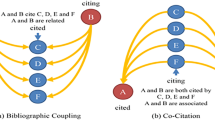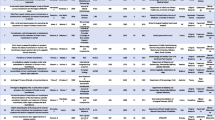Abstract
Introduction and Hypothesis
The study was aimed at systematically analyzing the research status and trends of pelvic organ prolapse (POP) using bibliometrics.
Methods
We retrieved documents published between 1975 and 2022 from the Web of Science Core Collection (WoSCC) database, and manually selected them for bibliometric analyses of country, institution, journal, highly locally cited documents and research trends based on co-citation clustering and keywords using the R Bibliometricx package and CiteSpace software.
Results
A total of 5,703 publications were included. Although the number of annual publications on POP increased, the trend of annual publication reached an obvious plateau in the first half of the 2010s. The USA, China, the UK, the University of Michigan, the University of Pittsburgh, and the University of Sydney were the top three countries and institutions with the most publications respectively. International Urogynecology Journal, American Journal of Obstetrics and Gynecology, and Obstetrics and Gynecology were the journals with the most extensive academic influence on the field of POP research. The international cooperation was lacking and the highly cited documents focused on high-level, evidence-based studies. Epidemiological studies and surgical treatment have achieved a plateau or decline. Recent studies have focused on conservative treatment, physical therapy, and minimally invasive surgery. In addition to evidence-based medicine studies, tissue engineering is the future direction of POP.
Conclusions
This study used bibliometric analyses to provide insights into the status and potential research directions of POP. More high-quality, evidence-based medicine studies and in-depth tissue engineering research should be propelled forward.





Similar content being viewed by others
Data Availability
The original contributions presented in the study are included in the article/supplementary file. Further inquiries can be directed to the corresponding author.
References
Barber MD, Maher C. Epidemiology and outcome assessment of pelvic organ prolapse. Int Urogynecol J. 2013;24(11):1783–90.
Pang H, Zhang L, Han S, et al. A nationwide population-based survey on the prevalence and risk factors of symptomatic pelvic organ prolapse in adult women in China—a pelvic organ prolapse quantification system-based study. BJOG. 2021;128(8):1313–23.
Walker GJ, Gunasekera P. Pelvic organ prolapse and incontinence in developing countries: review of prevalence and risk factors. Int Urogynecol J. 2011;22(2):127–35.
Petros PE, Ulmsten UI. An integral theory of female urinary incontinence. Experimental and clinical considerations. Acta Obstet Gynecol Scand Suppl. 1990;153:7–31.
DeLancey JO. Anatomic aspects of vaginal eversion after hysterectomy. Am J Obstet Gynecol. 1992;166(6 Pt 1):1717–24 (discussion 24–8).
Mangir N, Aldemir Dikici B, Chapple CR, MacNeil S. Landmarks in vaginal mesh development: polypropylene mesh for treatment of SUI and POP. Nat Rev Urol. 2019;16(11):675–89.
Ninkov A, Frank JR, Maggio LA. Bibliometrics: methods for studying academic publishing. Perspect Med Educ. 2022;11(3):173–6.
Yu X, Lin W, Zheng X, He L, Yang Z, Lin Y. Emerging trends on the mechanism of pelvic organ prolapse from 1997 to 2022: visualization and bibliometric analysis. Front Med (Lausanne). 2023;10:1158815.
Zhou Q, Lu M, Li GS, Peng GL, Song YF. Knowledge mapping and visualization analysis of pelvic organ prolapse repair with mesh from 2001 to 2021. Front Bioeng Biotechnol. 2023;11:1104724.
Huang F, Zhou Q, Leng BJ, Mao QL, Zheng LM, Zuo MZ. A bibliometric and social network analysis of pelvic organ prolapse during 2007–2016. J Chin Med Assoc. 2018;81(5):450–7.
Bump RC, Mattiasson A, Bø K, et al. The standardization of terminology of female pelvic organ prolapse and pelvic floor dysfunction. Am J Obstet Gynecol. 1996;175(1):10–7.
Olsen AL, Smith VJ, Bergstrom JO, Colling JC, Clark AL. Epidemiology of surgically managed pelvic organ prolapse and urinary incontinence. Obstet Gynecol. 1997;89(4):501–6.
Handa VL, Blomquist JL, Carroll M, Roem J, Muñoz A. Longitudinal changes in the genital hiatus preceding the development of pelvic organ prolapse. Am J Epidemiol. 2019;188(12):2196–201.
Woll A, Mbaye M, Edenfield A, Swift S. Genital hiatus size as a predictor of progression of pelvic organ prolapse. Female Pelvic Med Reconstr Surg. 2021;27(6):e555–8.
Sutkin G, Zyczynski HM, Sridhar A, et al. Association between adjuvant posterior repair and success of native tissue apical suspension. Am J Obstet Gynecol. 2020;222(2):161.e1–8.
Garcia AN, Ulker A, Aserlind A, Timmons D, Medina CA. Enlargement of the genital hiatus is associated with prolapse recurrence in patients undergoing sacrospinous ligament fixation. Int J Gynaecol Obstet. 2022;157(1):96–101.
Lin M, Lu Y, Chen J. Tissue-engineered repair material for pelvic floor dysfunction. Front Bioeng Biotechnol. 2022;10: 968482.
Emmerson S, Mukherjee S, Melendez-Munoz J, et al. Composite mesh design for delivery of autologous mesenchymal stem cells influences mesh integration, exposure and biocompatibility in an ovine model of pelvic organ prolapse. Biomaterials. 2019;225: 119495.
Mukherjee S, Darzi S, Paul K, Cousins FL, Werkmeister JA, Gargett CE. Electrospun nanofiber meshes with endometrial MSCs modulate foreign body response by increased angiogenesis, matrix synthesis, and anti-inflammatory gene expression in mice: implication in pelvic floor. Front Pharmacol. 2020;11:353.
Paul K, Darzi S, McPhee G, et al. 3D bioprinted endometrial stem cells on melt electrospun poly ε-caprolactone mesh for pelvic floor application promote anti-inflammatory responses in mice. Acta Biomater. 2019;97:162–76.
Diedrich CM, Guler Z, Hympanova L, et al. Evaluation of the short-term host response and biomechanics of an absorbable poly-4-hydroxybutyrate scaffold in a sheep model following vaginal implantation. BJOG. 2022;129(7):1039–49.
Darzi S, Alappadan J, Paul K, et al. Immunobiology of foreign body response to composite PLACL/gelatin electrospun nanofiber meshes with mesenchymal stem/stromal cells in a mouse model: implications in pelvic floor tissue engineering and regeneration. Biomater Adv. 2023;155:213669.
Lai C, Zhang SJ, Chen XC, Sheng LY, Qi TW, Yan LP. Development of a cellulose-based prosthetic mesh for pelvic organ prolapse treatment: in vivo long-term evaluation in an ewe vagina model. Mater Today Bio. 2021;12:100172.
Acknowledgements
We thank the Web of Science (WOS) team for allowing us to use their data. We would like to thank the Home for Researcher editorial team (www.home-for-researchers.com) for partial English-language editing services.
Funding
This study was funded by the National Natural Science Foundation of China (Grant No. 82071630, 81771560, and 81702745) and Construction of Key Disciplines of Tongji Hospital in the Fifth Cycle (ZD16-FC-1). The funding organizations did not contribute to any of the following: study design, data collection, data analysis, interpretation of data, writing the manuscript, or decision to publish.
Author information
Authors and Affiliations
Contributions
S.Z.: manuscript writing, data collection and analysis; Y.Y. and X.Y.: data collection and data analysis; X.Z.: study design and manuscript revision; X.T. and C.W.: project development, study design, and manuscript revision. All authors read and approved the final manuscript.
Corresponding authors
Ethics declarations
Ethics Approval
The study was approved by the Ethics Committee of Tongji Hospital, Tongji University School of Medicine.
Conflicts of Interest
None.
Additional information
Handling Editor: Holly E. Richter
Editor in Chief: Maria A. Bortolini
Publisher's Note
Springer Nature remains neutral with regard to jurisdictional claims in published maps and institutional affiliations.
Supplementary Information
Below is the link to the electronic supplementary material.
Rights and permissions
Springer Nature or its licensor (e.g. a society or other partner) holds exclusive rights to this article under a publishing agreement with the author(s) or other rightsholder(s); author self-archiving of the accepted manuscript version of this article is solely governed by the terms of such publishing agreement and applicable law.
About this article
Cite this article
Zhang, S., Yang, Y., Yang, X. et al. Bibliometric Analyses of the Research Trends of Female Pelvic Organ Prolapse. Int Urogynecol J (2024). https://doi.org/10.1007/s00192-024-05812-5
Received:
Accepted:
Published:
DOI: https://doi.org/10.1007/s00192-024-05812-5




